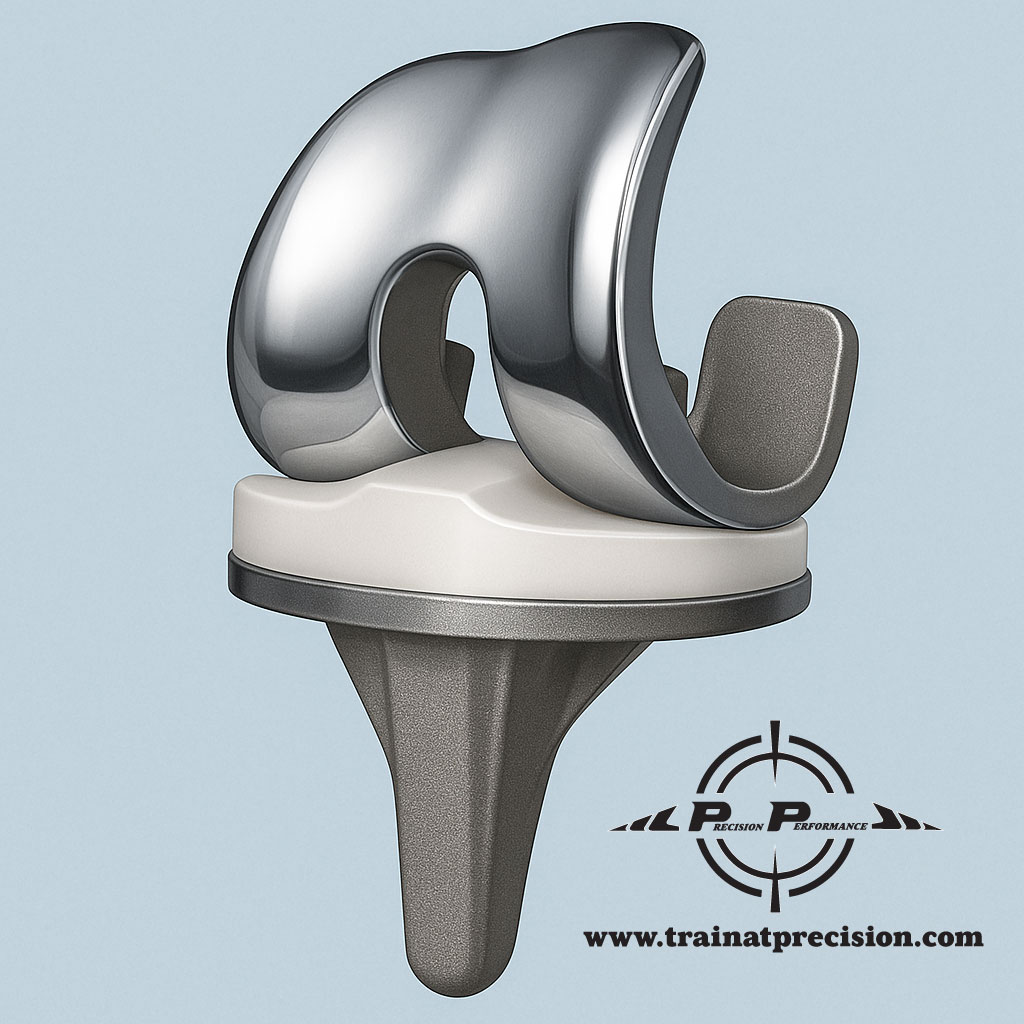Total Knee Replacement With Precision Performance and Therapy in Meridian, Idaho
At Precision Performance & Therapy in Meridian, ID, we specialize in helping patients recover after total knee replacement (total knee arthroplasty)—from early mobility all the way to full return to activity. Understanding the process helps you prepare, heal faster, and regain confidence in your new knee.
What Is a Total Knee Replacement (TKA)?
A total knee replacement, or total knee arthroplasty (TKA), is a surgical procedure that replaces the damaged joint surfaces of your knee with metal and medical-grade plastic components. The goal is to reduce pain, correct alignment, and restore function when arthritis or injury has severely damaged the knee joint.
During the operation, the surgeon removes the worn cartilage and bone from the femur (thigh bone) and tibia (shin bone) and resurfaces them with smooth artificial implants. A plastic spacer between the components allows the knee to move freely again without grinding or stiffness.
Why People Get a Total Knee Replacement
Common reasons for knee replacement include:
- Osteoarthritis – cartilage wear from age or overuse causing pain and stiffness
- Rheumatoid arthritis – autoimmune inflammation destroying joint surfaces
- Post-traumatic arthritis or joint degeneration – cartilage damage following injury or fracture
- Avascular necrosis – loss of blood supply to bone leading to collapse
- Severe deformity or instability – when knee alignment affects mobility or safety
When conservative treatments like physical therapy, bracing, medication, or injections no longer control symptoms, TKA can provide lasting pain relief and improved mobility.
Key Questions to Ask Before Surgery
Preparing well for surgery sets the stage for a smoother recovery. Common pre-surgery questions include:
- Do I truly need a TKA now, or can it wait?
- What are the risks and benefits of surgery for my specific health condition?
- How many knee replacements does my surgeon perform each year?
- What type of implant and surgical technique will be used?
- How should I prepare physically—should I start “prehab” exercises?
- What home modifications should I make for safety (e.g., grab bars, shower chair)?
At Precision Performance, we believe in the value in going into the surgery as prepared as possible. We consistently see faster and smoother recoveries when individuals are able to perform their post-surgery exercises for a few weeks prior to having the total knee replacement. Because of this, we want to help you start your recovery process before your surgery… FOR FREE. During your consult we will:
1) Answer any questions we can about your total knee replacement
2) Do a quick assessment and discuss areas you can focus on to improve your recovery
3) Review common early post-surgery exercises so you can practice them before the surgery
Call Or Text To Schedule a Free Pre-Surgery Consult
What to Expect During Surgery
The procedure typically lasts one to two hours under spinal or general anesthesia.
A small incision is made down the front of the knee, and damaged bone and cartilage are removed. The surgeon then fits and secures the new implant surfaces with medical-grade cement or a press-fit technique that allows bone growth into the implant.
You’ll spend a short period in recovery, and most patients stand and walk with assistance within 24 hours.

After Surgery: Common Questions About Early Recovery
- How much pain and swelling should I expect?
- Pain and swelling vary from individual to individual
- Pain control is managed through medication, ice, compression, and gentle motion.
- When can I start walking?
- Usually within 24 hours, using a walker or crutches at first.
- How long will I stay in the hospital?
- Many patients go home the same day or the next day.
- What activities should I avoid early on?
- Avoid kneeling, twisting, or high-impact movements until cleared by your surgeon or physical therapist.
Questions About Returning to Activity and Long-Term Function
- When can I drive? Usually 2–6 weeks after surgery once pain is controlled, narcotic pain medications are no longer being taken, and strength allows safe braking and vehicle control.
- When can I go back to work? Light jobs may resume in 3–6 weeks; heavy labor can require up to 3 months or more.
- Will I be able to kneel or squat? Some individuals find kneeling uncomfortable even after full healing, though it’s usually safe once strength and flexibility return.
- Can I return to sports? Low-impact activities like swimming, biking, and golf are encouraged. Running, jumping, and high-impact sports are typically not recommended.
How Rehabilitation Supports Recovery
Rehabilitation is the most important factor influencing outcomes after TKA.
At Precision Performance & Therapy, your rehab plan includes:
- Early activation: Walking and gentle motion progression as soon as your outpatient therapy program is initiated after surgery
- Quadriceps and hip strengthening: To reduce joint stress and improve gait stability
- Range of motion training: Aiming for 0° extension and at least 120°+ flexion
- Neuromuscular re-education and balance training: To restore normal movement and postural control
- Functional strength progression: To improve daily activity
- Gradual return to daily activities and sport-specific exercise
Most patients regain independence with walking, stairs, and household tasks within 4–8 weeks and continue building endurance over 3–6 months.
Returning to Normal Life
By following your physical therapist’s guidance, using pain management strategies, and staying consistent with exercises, most people achieve significant pain reduction and functional improvement.
At Precision Performance & Therapy, our goal is not just recovery—but helping you get back to the activities and lifestyle you enjoy most.
If you’re considering knee replacement or recovering from one, call 208-376-7313 or book online to start your customized recovery plan.

Frequently Asked Questions
- How long does it take to fully recover after a total knee replacement?
Most patients reach 80–90% of recovery by 3 months and continue to gain strength up to 12 months as long as they remain consistent with the therapy and exercise program. - Will I have pain after surgery?
Pain is common early on but typically improves steadily with medication, movement, and swelling control. - When can I return to driving?
Typically between 2–6 weeks, depending on leg strength and comfort. - Is outpatient or home-based physical therapy better?
Studies show home-based programs and clinic-based rehab are equally effective as clinic-based rehab when home-based programs are supervised properly. Clinic- or home-based programs can be utilized based on each individual’s personal preferences. - Will my knee ever feel “normal” again?
Many patients report their knee feels natural and pain-free within several months, though sensations like clicking, numbness, or stiffness can occasionally persist.
Schedule Here Start Your Total Knee Replacement Rehab Today!
- Buhagiar MA, Naylor JM, Harris IA, et al. Effect of inpatient rehabilitation vs a monitored home program on mobility in patients with total knee arthroplasty (HIHO): a randomized clinical trial. JAMA. 2017;317(10):1037-1046. doi:10.1001/jama.2017.1224. JAMA Network
- Barker KL, Lowe CJM, Toye F, et al. Outpatient physiotherapy versus home-based rehabilitation for patients at risk of poor outcomes after knee arthroplasty: the CORKA RCT. Bone Joint J. 2020;102-B(7):903-911. PMC
- Zhao BX, Cui Y, Zhang L, et al. Effectiveness and safety of outpatient rehabilitation versus home-based rehabilitation following total knee arthroplasty: a systematic review. BMC Musculoskelet Disord. 2023;24:—. doi:10.1186/s12891-023-06667-2. PMC
- Tousignant M, Moffet H, Nadeau S, et al. A randomized controlled trial of home telerehabilitation for post-knee arthroplasty. J Telemed Telecare. 2011;17(4):195-198. doi:10.1258/jtt.2010.100602. PubMed
- Moffet H, Tousignant M, Nadeau S, et al. In-home telerehabilitation compared with face-to-face rehabilitation after total knee arthroplasty: a noninferiority randomized controlled trial. J Bone Joint Surg Am. 2015;97(14):1129-1141. doi:10.2106/JBJS.N.01066. ResearchGate
- Zhao R, Li X, Wang Y, et al. A smartphone application-based remote rehabilitation system for post-TKA: a noninferiority randomized controlled trial. J Arthroplasty. 2024;39(3):—. doi:10.1016/j.arth.2023.11.062. Arthroplasty Journal
- Bade MJ, Struessel T, Dayton M, et al. Early high-intensity versus low-intensity rehabilitation after total knee arthroplasty: a randomized controlled trial. Arthritis Care Res (Hoboken). 2017;69(9):1360-1368. doi:10.1002/acr.23139. PubMed
- Jiao S, Liu H, Li J, et al. High-intensity progressive rehabilitation versus routine rehabilitation after TKA: randomized controlled trial. J Arthroplasty. 2024;39(4):834-842. doi:10.1016/j.arth.2023.08.063. PubMed+1
- Stevens-Lapsley JE, Balter JE, Wolfe P, Eckhoff DG, Kohrt WM. Early neuromuscular electrical stimulation to improve quadriceps strength after TKA: a randomized controlled trial. Phys Ther. 2012;92(2):210-226. doi:10.2522/ptj.20110124. PubMed+1
- Stevens-Lapsley JE, et al. Relationship between intensity of quadriceps NMES and strength recovery after TKA. Phys Ther. 2012;92(2):—. doi:10.2522/ptj.20110124. PubMed
- Yang X, Li Q, Zhang Z, Zhang Y, Xu S. Continuous passive motion after TKA: systematic review and meta-analysis. Arch Phys Med Rehabil. 2019;100(9):1763-1778. doi:10.1016/j.apmr.2019.03.016. PubMed+1
- American Academy of Family Physicians. Avoid routine use of continuous passive motion after knee arthroplasty. Choosing Wisely. Accessed Oct 7, 2025. American Academy of Family Physicians
- Adie S, Kwan A, Naylor JM, Harris IA, Mittal R. Cryotherapy after TKA: systematic review and meta-analysis of randomized controlled trials. J Arthroplasty. 2010;25(6):709-715. doi:10.1016/j.arth.2009.06.005. PubMed+1
- Liu MM, Tian M, Luo C, Wang S, Shao L. Continuous cryotherapy vs traditional cryotherapy after TKA: systematic review and meta-analysis. Front Surg. 2023;10:1073288. doi:10.3389/fsurg.2022.1073288. Frontiers+1
